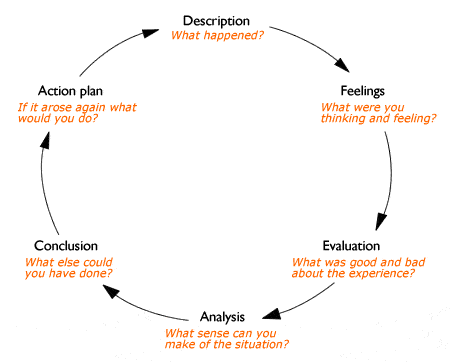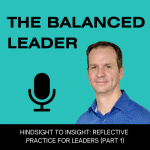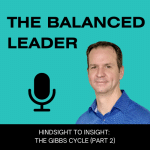One of the best tools I have found over the years to develop my leadership capability is reflective practice. Reflective practice is looking back on an event or a period of time with the intention of learning from it so we can improve for next time.
I am a firm believer that leadership can’t necessarily be taught in a classroom, although there are certainly models, theories and discussions that can be shared, the real learning happens in our day to day lives. We learn leadership by our actions, internal feedback, external feedback and reflecting on past situations. It’s about contextualising the lessons for your leadership style and situation. This is where reflective practice can help.
There are basically two ways of doing reflective practice: formally and informally. The focus of this post is going to be on the more formal approach, in particular by following a step-by-step method called the Gibbs Reflective Cycle.

Figure 1: Gibbs G (1988) Learning by Doing: A guide to teaching and learning methods. Further Education Unit. Oxford Polytechnic: Oxford.
The idea is to use this model as a guide to write about each of the headings in a journal or notepad. Each heading is a prompt to write what you noticed about different aspects of the event in question.
Description: What actually happened? This is where you give a factual account of the information at hand, noticing any subjective stories that are coming through. Try and remain as objective as possible.
Feelings: What were you thinking and feeling, both before the event and during it. Often we don’t look back to how our mood may have impacted the way things played out. Maybe we had just had a fight with our spouse. Maybe we couldn’t find a carpark near the office so had to drive around in circles for half an hour. These things could have shaped your feelings during the event, even though we don’t think about them at the time. And also reflect on what were you thinking and feeling during the situation?
Evaluation: What was good about the situation, and what was bad about it? We tend to think just because overall the situation didn’t go as well as it could have that everything must have been bad – but that’s not always the case. For example, the fact you had the difficult conversation despite it’s outcome is a good thing because at least it’s now out in the open.
Analysis: What sense can you make of the situation? Here you can be a little more subjective as you try and figure out what actually happened during the event you are reflecting on. Look for clues as to why the other person responded or behaved the way they did for example.
Conclusion: What else could you have done in the moment to change the course of the outcome? If the situation was negative, what steps could you have taken to bring things back on track? For example, if the other person escalated during a difficult conversation, did you escalate as well? Could you have been more mindful in this situation to affect a different outcome?
Action Plan: And if this situation arose again, what could you do differently next time to achieve a better result? What steps could you take before the situation to make sure things turn out better?

In the examples I gave above, the situations were mostly negative. However you can just as easily use the Gibbs Reflective Cycle for positive reflection. Reflect on a situation where things went really well and think about how you achieved it, and what you could do next time to get the same, or an even better results.
I write more about reflective practice and how to get the most out of your reflective practice in my new book The No-Bullsh*t Guide to Mindful Leadership. This book is full of simple yet effective techniques for being a more mindful leader.
Or, if you prefer to listen, I have recently created a two part series on Reflective Practice on my podcast The Balanced Leader Podcast. Click on the images below to listen to the podcast episodes.
If you liked this post, I would love for you to share it on your favourite social media platform.


